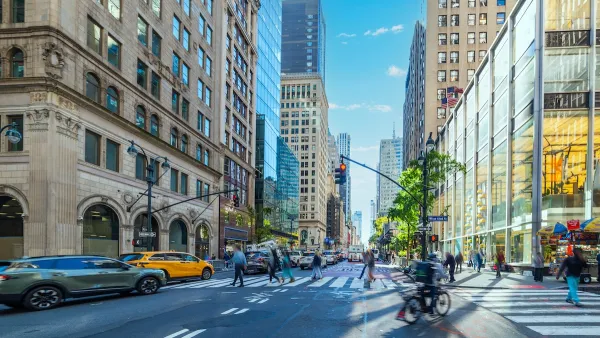The needs that drive complete streets policy are as unique as the communities they have taken root, but effective complete streets programs do share a few common traits.

"The concept of complete streets places the same priority on pedestrians, bicyclists and public transport users as on motorists," according to an article by Anna Bray Sharpin, Ben Welle, and Nikita Luke for TheCityFix that provides a guide to the core components of complete streets in the many global examples of complete streets programs. There are a lot of examples to choose from, according to the article, as "more than 1,140 agencies at the local, regional, and state levels have adopted complete streets policies in the United States, totalling more than 1,200 policies nationwide." And the idea has been translated around the world. "They are the so-called calles completas in Mexico, ruas completas in Brazil, and “streets for all” in India."
The post lists eight key elements to complete streets, listed below but detailed with more specificity in the article:
- An Active Streetscape
- Pedestrian-Scale Lighting
- Green Infrastructure
- Street Furniture
- Bicycle Facilities
- Signage
- Accessibility for All
- Surface Types
FULL STORY: What Makes a Complete Street? A Brief Guide

Maui's Vacation Rental Debate Turns Ugly
Verbal attacks, misinformation campaigns and fistfights plague a high-stakes debate to convert thousands of vacation rentals into long-term housing.

Planetizen Federal Action Tracker
A weekly monitor of how Trump’s orders and actions are impacting planners and planning in America.

Chicago’s Ghost Rails
Just beneath the surface of the modern city lie the remnants of its expansive early 20th-century streetcar system.

Bend, Oregon Zoning Reforms Prioritize Small-Scale Housing
The city altered its zoning code to allow multi-family housing and eliminated parking mandates citywide.

Amtrak Cutting Jobs, Funding to High-Speed Rail
The agency plans to cut 10 percent of its workforce and has confirmed it will not fund new high-speed rail projects.

LA Denies Basic Services to Unhoused Residents
The city has repeatedly failed to respond to requests for trash pickup at encampment sites, and eliminated a program that provided mobile showers and toilets.
Urban Design for Planners 1: Software Tools
This six-course series explores essential urban design concepts using open source software and equips planners with the tools they need to participate fully in the urban design process.
Planning for Universal Design
Learn the tools for implementing Universal Design in planning regulations.
planning NEXT
Appalachian Highlands Housing Partners
Mpact (founded as Rail~Volution)
City of Camden Redevelopment Agency
City of Astoria
City of Portland
City of Laramie





























